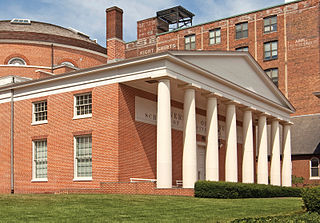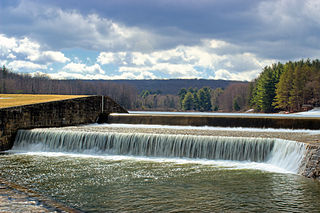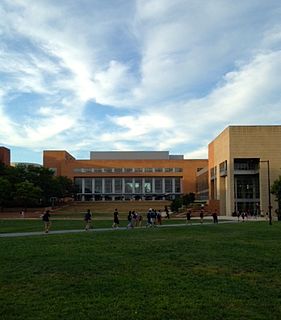
The University of Maryland, Baltimore County (UMBC) is a public research university in Baltimore County, Maryland. It has a fall 2020 enrollment of 13,497 students, 61 undergraduate majors, over 92 graduate programs and the first university research park in Maryland. It is classified among "R1: Doctoral Universities – Very High Research Activity".

The University of Maryland, Baltimore (UMB) is a public university in Baltimore, Maryland. Founded in 1807, it comprises some of the oldest professional schools of dentistry, law, medicine, pharmacy, social work and nursing in the United States. It is the original campus of the University System of Maryland and has a strategic partnership with the University of Maryland, College Park. Located on 71 acres (242,811 m2) on the west side of downtown Baltimore, it is part of the University System of Maryland. UMB's mission is to improve the human condition and serve the public good of Maryland and society at-large through education, research, clinical care, and service.

The Nicholas School of the Environment is one of ten graduate and professional schools at Duke University and is headquartered on Duke’s main campus in Durham, N.C. A secondary coastal facility, Duke University Marine Laboratory, is maintained in Beaufort, North Carolina. The Nicholas School is composed of three research divisions: Earth and Climate Sciences, Environmental Sciences and Policy, and Marine Science and Conservation. The current dean of the Nicholas School is Toddi Steelman.

Spring Grove Hospital Center, formerly known as Spring Grove State Hospital, is a psychiatric hospital located in the Baltimore, Maryland, suburb of Catonsville.

The National Wilderness Preservation System (NWPS) of the United States protects federally managed wilderness areas designated for preservation in their natural condition. Activity on formally designated wilderness areas is coordinated by the National Wilderness Preservation System. Wilderness areas are managed by four federal land management agencies: the National Park Service, the U.S. Forest Service, the U.S. Fish and Wildlife Service, and the Bureau of Land Management.
Cera or CERA may refer to:

Parker Dam State Park is a 968-acre (392 ha) Pennsylvania state park in Huston Township, Clearfield County, Pennsylvania in the United States. The park is surrounded by Moshannon State Forest. Parker Dam State park is 17 miles (27 km) north of Clearfield on Pennsylvania Route 153 just off exit 111 of Interstate 80. The park was constructed during the Great Depression by the Civilian Conservation Corps. They built many of the facilities that are in use today at Parker Dam State Park.
Garrison Forest School (GFS) is a non-denominational private college preparatory boarding and day school located on a 110 acres (45 ha) campus in Owings Mills, Maryland. GFS offers kindergarten through 12th grade for girls as well as a co-educational program for pre-K. The school is accredited by the Middle States Association of Colleges and Secondary Schools and the Association of Independent Maryland Schools.

The University of Michigan School for Environment and Sustainability (SEAS) is an interdisciplinary professional school focused on the environmental natural and social sciences, environmental justice, and sustainable landscape architecture. SEAS provides graduate-level degrees at the master’s and doctorate levels, along with undergraduate degrees through the Program in the Environment (PitE), a university-wide collaboration.
The College of Food, Agricultural and Natural Resource Sciences (CFANS) is one of seventeen colleges and professional schools at the University of Minnesota. The college offers 13 majors, 3 pre-major and pre-professional majors and 26 freestanding minors for undergraduate students and a variety of graduate study options that include master's, doctoral and joint degree programs.
Established: 1978
Type: Public
Location: University System of Maryland, USA
Website: http://www.mees.umd.edu]]
The Center for Urban Environmental Research and Education (CUERE) was created in 2001 with support from the Environmental Protection Agency and the U.S. Department of Housing and Urban Development. The facility is located in the Technology Research Center on the campus of the University of Maryland, Baltimore County in Baltimore, Maryland, allowing for opportunities for UMBC students and faculty. The center's focus is primarily on the relationship between natural and socioeconomic processes that occur in urban environments. CUERE's location allows for ample research opportunities in the Baltimore-Washington metropolitan area.

The College of Arts, Humanities and Social Sciences at the University of Maryland, Baltimore County (CAHSS) has 22 departments, and offers 30 Bachelor's, 16 Master's, and 6 Ph.D. programs. The college also includes several scholarship programs; the Linehan Artist Scholars Program, the Humanities Scholars Program, and the Sondheim Public Affairs Scholars Program. The college oversees several centers; the Dresher Center for Humanities, the Imaging Research Center, and the Maryland Institute for Policy Analysis and Research.

The Albin O. Kuhn Library & Gallery is the official library of the University of Maryland, Baltimore County in Catonsville, Maryland. It is located in the center of the campus at the confluence of Academic Row and Walker Avenue. The library features 1 million+ books & bound journals, 1.9 million+ photographs and slides, 30,000+ sound recordings, 800,000+ microform pieces, 1,200+ linear feet of manuscripts/archives, 180,000+ government documents, and 100,000+ slides. In addition to the stacks, the Albin O. Kuhn Library also features the Library Gallery, the UMBC Special Collections, the Retriever Learning Center and Math Lab, Resources Learning Center, a cafe, and administrative offices.

Bwtech@UMBC Research and Technology Park is the university research park for the University of Maryland, Baltimore County in Baltimore, Maryland. The research park has two campuses; bwtech@UMBC North, located just south of the main campus and adjacent to the campus gateway, and bwtech@UMBC South, located in UMBC's South Campus complex off of Rolling Road.

Joseph Beuys Sculpture Park is a park located on the campus of the University of Maryland Baltimore County (UMBC) in Baltimore County, Maryland, inspired by Joseph Beuys' extensive 7000 Oaks tree planting project. The original project transformed the sidewalks and landscape of Kassel, Germany, with the planting of 7,000 oak trees between 1982 and 1987. As part of the Tree Partnership, over 200 trees were planted among Patterson Park, Carroll Park, and Wyman Park in Baltimore.
The University of Maryland, Baltimore County (UMBC) features a variety of research centers and institutes both based on the campus and affiliated with other academic institutions. These centers and institutes listed below seek out to expand their research, educate, and promote partnerships between the university and the Baltimore-Washington Metropolitan Area and beyond.
UMBC Transit is the official bus system of the University of Maryland, Baltimore County. Along with the Maryland Transit Administration (MTA), the UMBC community has public transit access to nearby areas such as Catonsville, Arbutus, Maryland, and Baltimore City.

The Commons at the University of Maryland, Baltimore County is the central student activities center of the university campus. Opened in 2002, "The Commons" includes meeting rooms, food and retail outlets and a book store. Also incorporated into the building is a gameroom, facilities for the student government association, a campus pub, bank and a copying center. In addition, The Commons hosts numerous events such as Quadmania, Big Crazy Fun Night, orientations, fraternity events, and much more.













